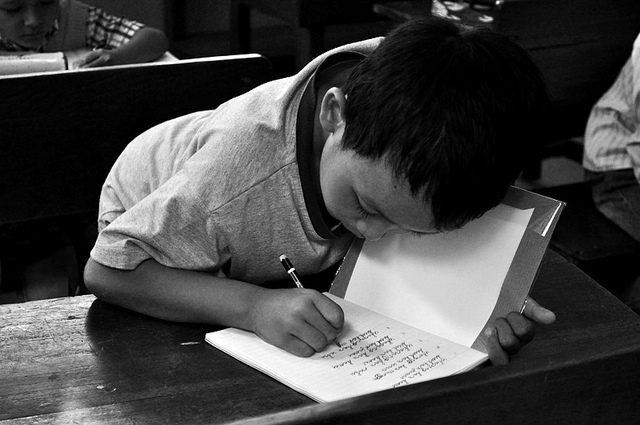Translated by Sasha Reiter
The immense differences and shallow regional asymmetries that characterize Mexico, remain reflected in one of the most important sectors for the development of any society: education.
Although the educational cost represents the 5.2 percent of the GDP, a figure that surpasses that of many other nations, Mexico, according to date from the OCDE, is located within the last places in what is referred to as an education index. More than 80 percent of the expended budget in the sector is spent on the payment of teachers, many scholarly structures are in deplorable condition. Some do not have restrooms or ramps for the disabled and in general the recreation areas are insufficient.
The students, in dramatically high percentages, do not succeed in passing the national general knowledge exams, “Planea”. According to data from the Secretary of Social Development, nearly 6.6 percent of the population is illiterate, this is to say more than six million people.
All of these bad things only get worse in the poorest provinces.
In Tabasco, Guerrero and Sonora the percentage of students who do not pas the general knowledge exams reaches 80 percent and the illiteracy in Oaxaca and Chapas reaches peaks of 20 percent. According to data from the Education Census realized by the National Institute of Statistics and Geography, one third of the schools of Oaxaca and Chapas do not have bathrooms or ramps for the disabled.
On top of such a huge problem, the primary cause of the lack of opportunities for a future for the Mexican youth, the government of President Peña Nieto presented an education reform that was approved by the majority of the Parliament.
The reform introduces; merit based granting of teaching positions through an open application and evaluation process, the mandatory evaluation of the teachers currently in position, and, when first introduced, also led to the termination of teachers taking the evaluation, if it was failed three times.
These measurements, that were supposed to improve the quality of the education system, were received as a threat by the workers of the labor union CNTE. The union unites almost 110mil affiliates, and is principally based in the south of the country, in the provinces of Chiapas, Oaxaca, Guerrero and Michoacán, all of them very poor, with an economy that is mostly based in agriculture and a GDP per capita five times less than that of Mexico City.
Misery and corruption- these are the two ingredients that are at the core of a system of cronyism that has handled the union, with the coexistence of the province and in particular of the IRP (Institutional Revolutionary Party) to which the President Peña Nieto belongs, to assign the teaching positions.
The education reform that Peña Nieto puts in place would break a very dark modus operandi. Under which, according to reports and studies of diverse organizations and NGOs, they are paying thousands of irregular salaries, remunerated to dead people, or in pension, they offer the possibility to bequeath office and a fixed quota for teachers who leave regular schools, the reservoir of the central union.
At the same time, the education reform risks the subsistence of many families who live on teachers’ salaries and many honest people who, with great effort and sacrifice, have completed their studies in populations where most live in conditions of profound misery. Not to mention the rooted mistrust that many of them feel towards the transparency of the jurors called to assess their evaluations.
Moved by those fears, thousands of citizens have united at the protests organized by the CNTE. Marches, closed streets, protests of various kinds have flared up in towns and cities, and, unfortunately, there were those who paid with their lives for their disconformity. Nineteen civilians were shot dead in Nochixtlán, town of Oaxaca, after a long encounter with the police. A massacre that has shaken the entire country and forced both sides to seek a dialogue.
It is not an easy negotiation, what with the central union asking for the annulment of the education law that Peña Nieto defends firmly.
In reality, Peña Nieto is risking a lot, with this reform, in light of the next elections. It is his weapon with which to demonstrate a firm hand against old and new corruption. On the other hand, the aspiring president Manuel López Obrador, candidate in the previous elections, took the defensive of the members of the CNTE and of all who oppose the reform.
While on one hand, the majority of the population is shouting for an education reform that opens new possibilities for the future of the youth, on the other the weight of the blood spilled in Nochixtlán is large.
Government and unions know that they must find an agreement, that the dialogue is necessary to find consensus and solutions that are decent for all.
The real challenge will be to resolve the social and economic inequalities between the Mexican provinces. It will be very difficult to imagine a reform that can project education toward excellency without deepening the differences between the capital and the poorest provinces.


